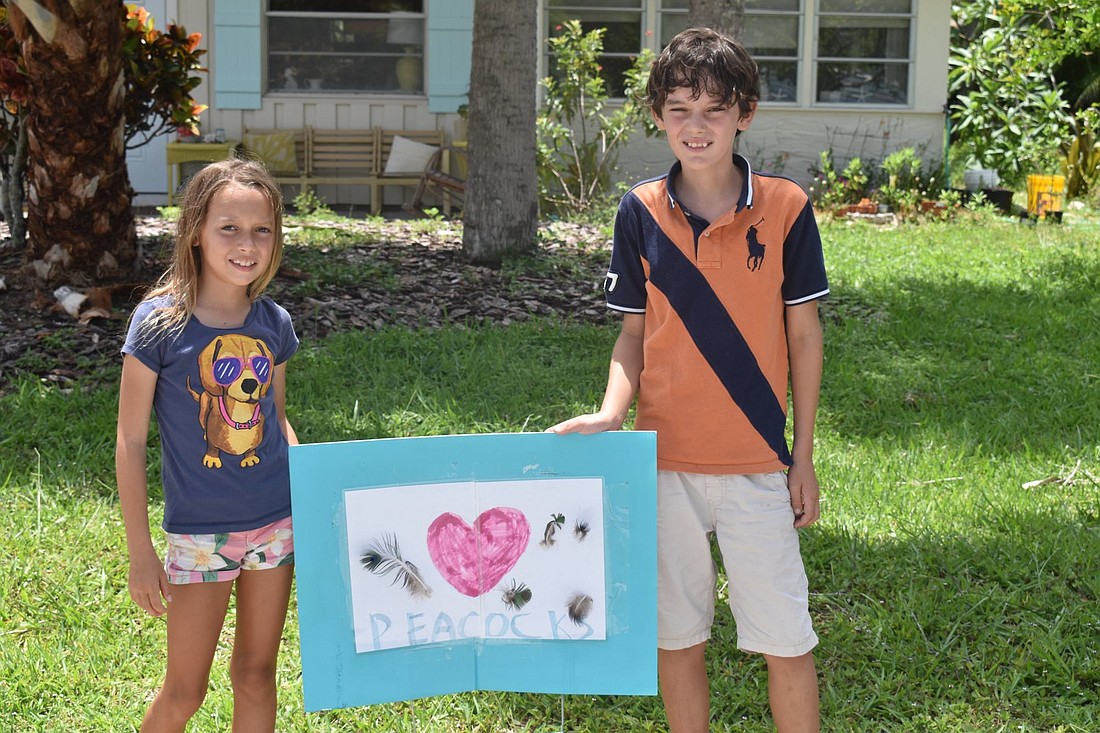- July 9, 2025
-
-
Loading

Loading

A letter from an 11-year-old boy this summer relaunched a sometimes acrimonious public debate, dormant for years, over peacocks in Longbeach Village.
Brice Claypoole, who moved here with his family in September 2018, wrote to Vice Mayor Ed Zunz in July about his fondness for the neighborhood's peafowl and his hope that a new batch of babies could stay. It's been years since the last dust-up in the north end over peacocks, which can be stunning to look at but are also loud, leave droppings behind and tend to foul up normal life. At one point in 2015, the peacock population moved into triple digits and the town budget to rid them hit five.
“I understand that we cannot have 100 peacocks — that would be a disaster — and that their population will have to be controlled in a kind way,” Claypoole wrote. “But I do not want this to be the end of the peacocks, and I want these babies to be allowed to grow up.”
Brice, who along with his sister, Coco, named several of the birds, has a small sign in his yard proclaiming his support for them. He's made signs for other residents, too. Zunz's 8-year-old granddaughter wants one.
The town maintains that keeping the flock to about 12 is what’s best for Village residents, given a difficult situation and opposing views. But even that is tricky, largely because of an especially hard-to-catch female that bears young every so often.
In his response to Brice and his mother Ali Foster, Zunz explained the history of peacocks in the Village and, in turn, the town’s policy to trap and relocate them while leaving a small flock of males behind.
“My young granddaughter shares your regret,” Zunz wrote.
“Moe’s still back there,” Brice told a reporter as he ran from his backyard with his sister, Coco.
Moe, a full-grown male, is a frequent visitor at Brice's house. Rainstorm, another male, is often nearby, sometimes on the roof of the house next door.
“They’re pretty chill, they’re used to people,” Foster said. “They’re kind of like squirrels.”
The new Longbeach Village residents enjoy keeping tabs on the birds and haven't seen many reasons to dislike them. Foster said the presence of the quirky birds is one of the reasons the family settled on Longbeach Village as their home. “They’re never aggressive, that’s something we’ve never seen,” Brice said.
Brice and Coco, who are homeschooled, have researched peacocks and their variations. Sometimes, one will peek in a window.
“I’ll just see a little head come around (the window) like, ‘Hey,’ ” Foster said.
The family doesn’t feed the peacocks often — they’re nothing close to pets, Foster said. The baby birds eat plants, and sometimes lizards, Brice and Coco said.
The Claypoole siblings have made nine signs for people to put in their yards that emphasize the message of loving peacocks. But the signs aren’t an accurate measure of peacock support, Foster said.
“Some people like the peacocks but don’t want to get into the fight,” she said.
“If there were 150, I could understand, even if we liked them,” Foster said. “But we’re definitely not at 12 males, we’re at six.”
Once in receipt of Brice's e-mail, Zunz said he checked with the town on its protocol. He was surprised to learn the town had annually been snaring babies before they could fly.
Zunz relayed to the Claypooles the town’s position on Village peacocks while empathizing with their stance. He invoked his granddaughter, who is pro-peacock and lives in the Village. He even arranged a meeting between for his granddaughter and Town Manager Tom Harmer, who explained the policy to her.
Streets, Facilities, Parks & Recreation Manager Mark Richardson has been personally charged with removing peacocks from the Village. In 2015 he was given the directive by the Town Commission to remove all peahens (female peacocks) and to leave 10-12 males, and he’s been following that direction since.
Richardson, like Zunz, contends that nothing much has been made of peacocks during the past few years, and, while they understand what the Claypooles want, they think the new complaints ignore recent history and existing practice.
While the Town has been largely successful in culling the Village’s peafowl population, a particularly cagey peahen has eluded authorities for years. She has repeatedly had chicks, and, according to Richardson, birthed five last year, as she’s done again this summer. If she had been relocated, Richardson thinks, peacocks wouldn’t even be a topic of discussion right now. And, Richardson said, a change in town policy has allowed her to remain evasive.
“In 2016, we had caught all the peacocks we could in cages with the vendor we were using, so the next step was to use tranquilizer,” Richardson said. “The commission approved to move ahead with that. When you have a gun and you're shooting a dart and it’s tranquilizing a bird, that’s more of a scene than tracking them and putting them in a cage. There was a lot of outcry to Town Hall."
No more tranquilizer guns, fish nets are used, and the female remains on the loose.
Richardson said he hasn't picked up any peachicks (baby peacocks) for relocation this year, adding five hatched but one disappeared -- similar to last summer.
The birds are relocated by a vendor to the mainland, but the vendor has different options on where to release them. There are currently no plans for the Town to change its peacock protocol.
The recently born babies are beginning to grow up and are close to the point at which their genders can be determined. Females have to go, to prevent multiplication. But the males?
“We’re not advocating for all the peacocks to come back,” Foster said. “That’s not what I said. We would hate for this to be the end of this tradition. It’s part of what attracted me to the Village.”